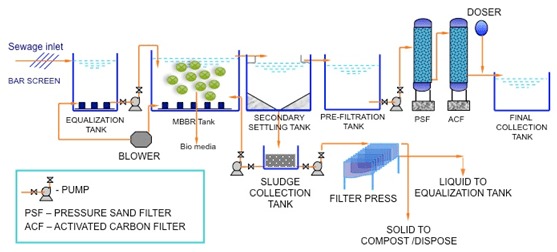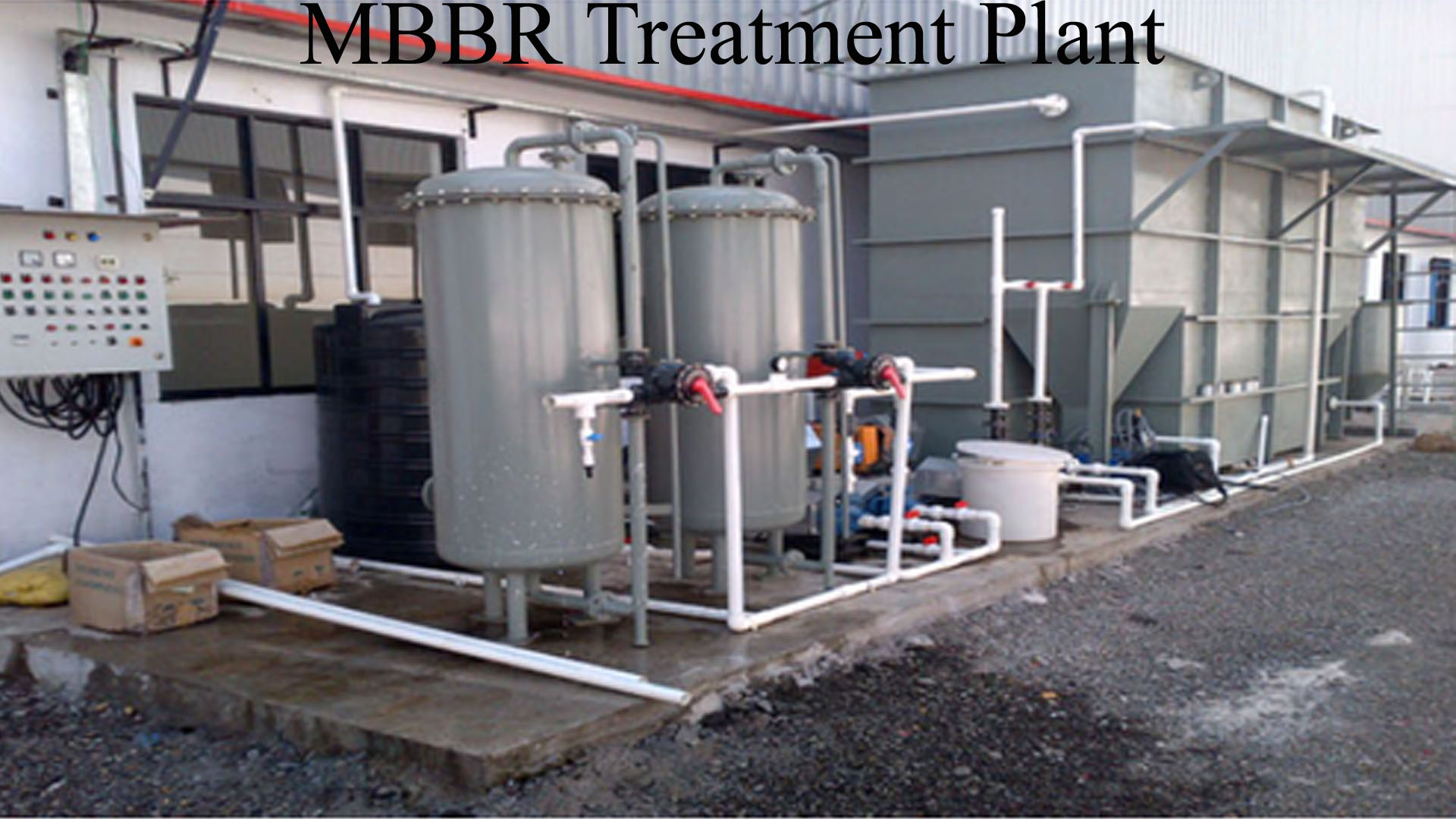MBBR Based STP
Moving bed biofilm reactor (MBBR) is a biological technology used for wastewater treatment process suitable for municipal and industrial application. Another common name is moving bed film reactor. It was invented in the 1980s. MBBR offer an economical
solution for wastewater treatment. STP MBBR technology is the use of a moving bed biofilm reactor in sewage treatment plants.
MBBR wastewater treatment system enables efficient results
of the disposal using low energy. The technology is used to separate organic substances, nitrification and denitrification. MBBR design is made of an activated sludge aeration system. The sludge is collected on the plastic
carriers which have a large internal surface area. The surface area in the carriers optimizes the contact of water, air, and the bacteria.
MBBR activated sludge is the application of MBBR media to an overloaded treatment
plant when upgrading.
MBBR is applicable to the different quality of wastewater treatment. The application is determined by the desired results and regulations controlling discharge. The system can be of more than
one stage depending on specific needs. The stages are made of individual tanks separated by screens to ensure that bacteria remain in their specific tank.
MBBR Media Used in Wastewater Treatment Aeration tank: The
tank is similar to an activated sludge tank. The aeration is used to keep in motion the activated sludge and carriers. The MBBR system separates the excess bacteria and sludge which are directed to the final separator.
Special plastic carriers: They provide a surface for biofilm growth. Carrier materials are made of materials with a density close to that of water (1g/cm3) an example is high-density polyethylene (HDPE) with a density
of 0.9g/cm3. These carriers are moved in the tank through the aeration system. This ensures good contact between the wastewater and the biomass on the carriers.
Benefits of MBBR Technology Saving of space due to its
compactness Easy to maintain Good for a high volume of load Extension and expanding are easy. This made possible by increasing the filling degree of carriers. Lower discharge costs MBBR is not affected by toxic shock Independent
process performance because there is no return line for sludge; the MBBR eliminates the return activated sludge (RAS) It has high effectiveness of sludge retention time (SRT) which enhances the nitrification process Production
of sludge is lower It does not need recycling of the sludge-like activated sludge system MBBR media is installed to retrofit existing activated sludge tanks in order to increase its capacity Design of MBBR Systems It uses
a combination of activated sludge process i.e. suspended growth and biofilter i.e. attached growth. It uses the entire tank volume for biomass growth by implementing the carriers for attached growth of biofilm. Movement
of carriers is enabled by air bubbles through agitation.
The reactor can be in any shape and support different load depending on carrier filling. MBBR design of reactor depended on the actual wastewater characteristics
and locality. The plants come either with vertical or horizontal mounted rectangular mesh sieves. The reactor can also be fitted with cylindrical bar sieves.
MBBR carriers are cylinders having a cross inside and fins
outside to increase the surface area. The standard used is below 70% of carriers in an area of not more than 465m2 per m3. MBBR is used together with a septic tank or a pre-coagulation step for pre-treatment. MBBR technology
can be designed with additional non-mechanical or mechanical system to enhance phosphorus and fecal coliform reduction.
Application of MBBR Biological Oxygen Demand (BOD) removal – It requires only one wastewater tank
with the MBBR and clarification. Nitrification – It uses two tanks one for BOD removal and the other for nitrification. Denitrification – It uses four aeration tanks in this order before emptying in the clarification with
pre denitrification, BOD reduction, nitrification and post denitrification. MBBR technology is applicable in industries, marine and for municipal wastewater treatment. Operation and Maintenance of MBBR MBBR which is in
constant use does not require backwashing or return sludge flows. Wastewater treatment tank operation is at low cost because of the coarse-bubble aeration in the aeration zone. The agitation constantly moves the carriers
over the service eliminating clogging. Maintenance of the MBBR system is mainly done in the form of screening, sludge handling, influent equalization and it also involve maintaining the integrated control system and clarifier
system. The MBBR requires skilled personnel for the routine monitoring of pump and blower operation. MBBR technology has a self-maintenance mechanism for the level of biofilm.
MBBR vs MBR Membrane bioreactor is based
on a combination of conventional activated sludge and biofilm media. Comparison between MBR and MBB can be done using the following key criteria: Capital investment of MBR is higher than of MBBR MBR requirement for screening
is higher than that of MBBR technology MBBR system does not require chemicals in its operation like MBR system MBR system is difficult to operate as compared MBBR MBR requires recirculation pump and air scouring blowers
which are not applicable in MBBR Both systems require aeration blowers In case of power shutdown, MBR can last up to 24 hours while MBBR lasts up to 10 hours after which the bacteria forms bio-cakes. MBR is better in shifting
of complex or toxic substances than MBBR MBR effluent water quality is superior but MBBR`s is suitable for irrigation purpose only Both are susceptible to oil and grease for MBR membrane can be cleaned well or replaced
but for MBBR technology the carriers need to be changed and the plant will require a ten-day restarting time. Conclusion The quantity of biomass plays a big role in the removal efficiency of the MBBR system, it can be increased
through the volume of carriers per unit. The carrier’s performance needs to be proven for specific wastewater treatment for application of different cases. Design of a water treatment plant should not be based on assumption
or estimation but the correct material should be used for the carrier and the volume required calibrated.
MBBR technology is effective for wastewater treatment if the regulation concerning the effluent water discharge.
The system is flexible in its application and can easily be relocated. Wastewater treatment as required for ecological reasons can be done using the MBBR.

PACKAGED SEWAGE TREATMENT PLANT (STP PLANT)
Quite commonly, centralised sewage treatment plants (STP Plants) are in practice. However, because of the large volume discharged at one place, the centralized
sewage treatment plants aggravate the environmental problem. Considering the environmental challenges posed by centralised STPs and current legislative guidelines, the decentralised sewage treatment plants are becoming
more practical and popular. In line with this consideration, we have indigenously developed packaged STP Plant that meets individual requirements. It is simple to operate and requires minimal maintenance, power, land and
consumables. The packaged STPs are manufactured in MS (with FRP lining or epoxy coated) or moulded FRP as per specific need. We offer range of STPs for 5 cu.m. Per day to 500cu.m. Per day. These compact plants are ideal
for hotels, industries, hospitals, holiday resorts, schools, housing colonies, industrial/commercial complex, shopping malls, residential apartments, hostels, site offices, etc. for its various benefits.
THE BASIC
OPERATION OF PACKAGED STP PLANT INVOLVES
• Aeration based on Moving Bed Bio-Reactor (MBBR) principle
• Secondary solid separation
• Disinfection
• Final filtration
BENEFITS OF PACKAGED STP PLANT
• Reusability of treated water
• Releases no bad smell
• Zero sludge generation
• Less footprint
• Easy mobility
